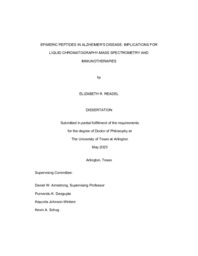
ATTENTION: The works hosted here are being migrated to a new repository that will consolidate resources, improve discoverability, and better show UTA's research impact on the global community. We will update authors as the migration progresses. Please see MavMatrix for more information.
Show simple item record
| dc.contributor.advisor | Armstrong, Daniel | |
| dc.creator | Readel, Elizabeth | |
| dc.date.accessioned | 2023-06-14T17:06:39Z | |
| dc.date.available | 2023-06-14T17:06:39Z | |
| dc.date.created | 2023-05 | |
| dc.date.issued | 2023-05-19 | |
| dc.date.submitted | May 2023 | |
| dc.identifier.uri | http://hdl.handle.net/10106/31253 | |
| dc.description.abstract | Evidence has shown that the extracellular deposition of amyloid-beta (Aβ) peptide is a contributing factor of Alzheimer’s disease. Further, modifications to Aβ peptides may enhance the deposition of Aβ plaques and/or contribute to the neurodegeneration in AD patients. These aberrations include the isomerization and epimerization of L-Asp and D-Ser residues to form D-Asp, L/D-iso-Asp, and D-Ser residues, respectively. Therefore, considerable effort has been expended to create effective methods to distinguish such aberrant Aβ peptides from wild type. A useful technique to extract aberrant Aβ peptides in AD patients is by immunotherapies, or antibodies. A few immunotherapies are thought to provide some benefit. It is possible that a contributing factor to the responses of such therapies may be the presence of modified, or aberrant, Aβ peptides found in AD patients. Modifications to Aβ peptides may enhance the deposition of Aβ plaques and/or contribute to the neurodegeneration in AD patients and may alter the binding affinity to antibodies. Herein, we have developed two high-throughput chromatographic identification methods using high performance liquid chromatography-tandem mass spectrometry (HPLC-MS/MS). The first method profiles all 20 isobaric Aβ peptide epimers containing Asp, iso-Asp, and Ser isomers using modified Q-Shell and NicoShell chiral stationary phases. The second method uses a chromatographic retention U-shaped curve to investigate the hydrophobicity of Aβ 1-38, 1-40, 1-42 and fourteen aberrant Aβ 1-42 peptides. The U-shaped curve helped us develop an efficient, selective and comprehensive method to detect both aberrant and wild type A peptides simultaneously. The U-shaped curve also provides insight of the hydrophilic characteristics of D-Ser, D-Asp, and iso-Asp modified peptides. Additionally, we used immunoprecipitation to examine the binding affinity for four antibodies against 18 epimeric and/or isomeric Aβ peptides. Tandem mass spectrometry was used as a detection method, which also was found to produce highly variable results for epimeric and/or isomeric Aβ. These analytical strategies allow the direct detection and identification of all possible Asp, iso-Asp, and Ser stereoisomers in Aβ. | |
| dc.format.mimetype | application/pdf | |
| dc.language.iso | en_US | |
| dc.subject | amyloid-beta, mass spectrometry, isomers, epimers, Alzheimer's Disease | |
| dc.title | EPIMERIC PEPTIDES IN ALZHEIMER’S DISEASE: IMPLICATIONS FOR LIQUID CHROMATOGRAPHY-MASS SPECTROMETRY AND IMMUNOTHERAPIES | |
| dc.type | Thesis | |
| dc.date.updated | 2023-06-14T17:06:40Z | |
| thesis.degree.department | Chemistry and Biochemistry | |
| thesis.degree.grantor | The University of Texas at Arlington | |
| thesis.degree.level | Doctoral | |
| thesis.degree.name | Doctor of Philosophy in Chemistry | |
| dc.type.material | text | |
| dc.creator.orcid | 0000-0003-0670-2460 | |
Files in this item
- Name:
- READEL-DISSERTATION-2023.pdf
- Size:
- 2.560Mb
- Format:
- PDF
This item appears in the following Collection(s)
Show simple item record


